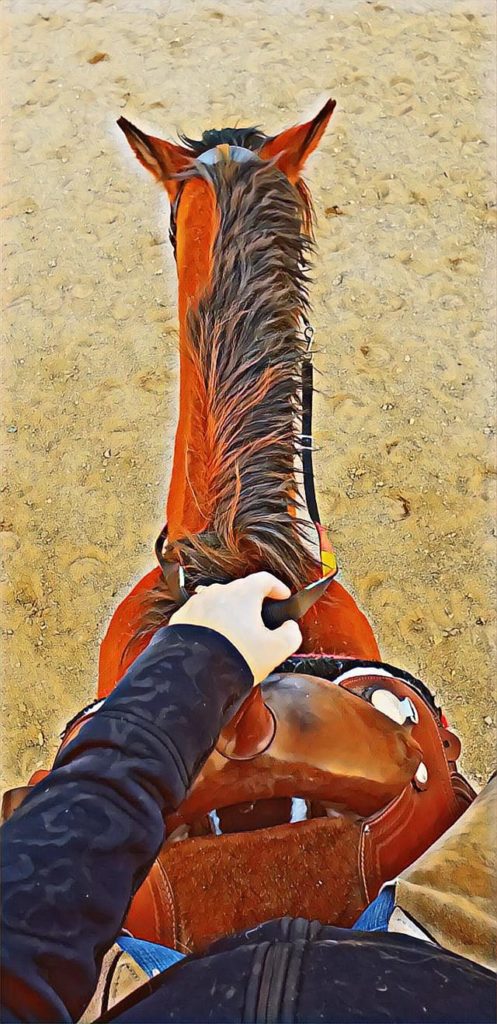Or are you more than your discipline of choice?
Yes…I prefer my dressage saddle over a western saddle and my breeches over chaps. But I dont let my “English” tack lock me and my students into a box.
Don’t limit you or your student’s progress due to a type of saddle, your preferred discipline, or the attire you like.
Keep an open mind and always be looking for learning opportunities….and teach having an open mind and the desire to constantly learn.
There is something to learn from every discipline, every horse, every trainer, every student.
Saying “I ride western so I dont need to know ‘x’ because that is an English thing” just narrows your range of knowledge. (Insert any other discipline in lieu of ‘western’ and ‘English’ because it applies to everyone!)
If you’re willing to look…you would be surprised at how similar those “great riders” and “well trained horses” are when you strip away the discipline specific attire and equipment.
A good rider/horsemen is a good rider/horsemen no matter what tack you put them in or the attire they choose to wear.
A well trained horse is a well trained, well rounded, well mannered horse and should know certain fundamental things no matter the discipline it may be asked to specialize in.
The points below also apply to my adaptive and able bodied students.
I try so hard to instill in them an open mind and the mindset that just because we happen to ride in an English or Dressage saddle right now does not mean that you are a ‘dressage’ rider…you are learning to be a good rider and just happen to be in a Dressage saddle (because it sets you up in a good position). I try to teach them how to be a balanced, adaptable, and functional rider that can ride in any equipment on various horses.
Keep an open mind. Teach an open mind.
- My preferred saddle is dressage…but I can ride well in any equipment (I wont lie…some saddles make it much more difficult because they go against good mechanics).
- My preferred method is classical and balanced style….but I still love learning about other seats and their similarities, differences, and history. I take pieces and learn from each and apply them as needed.
- I prefer to ride two handed in the most mild setup possible and most of my head stalls look English…but I can ride one handed, in a shank, with a large port, in a bosal, in a hack….
- I want my horses to be well rounded. Yes, they may look like an English or Dressage horse due to their build and tack…but they go on trail rides, can push cows, open gaits, work though desensitization obstacles, hack on a loose rein, and have excellent ground manners.
- I may prefer breeches and half chaps for riding…but I still own a pair chaps and wear cowboy boots and button downs on a regular basis.
- I choose to rarely use artificial aids….but can competently ride with them and have made an effort to learn the time and place to use them…and this applies not only to me but also when a student is on a horse
Yes….we all have our preferences and ‘looks’ that are more appealing to our eye…but strive to do the best by your horse, by your student, and yourself.
Keep an open mind. Teach an open mind.
Instead of doing things because it is ‘English’ or ‘dressage’ or ‘western’…ask yourself:
- Is it ethical?
- Is it mechanically sound for the human and horse?
- Is it safe for horse and human?
- Are you setting the horse and human up for success?
- Is it functional?
You might be surprised what lays outside the “box” created by your discipline or attire of choice.



I use thick bareback with surcingle, (freedom rider) English for short legs, western for enhanced balance when I need to work on rein control, bareback to establish muscle memory for reflexes in respsonse to movement. etc. All determined by the physical and mental circumstances of the students. However, everybody starts out on padded vaulting barrel including me just to get the joints oiled if for no other reason. Everybody goes through a series of hippotherapy poses on the barrel before ever getting on the horse just so I can see if they are even flexible enough to get on , how strong is their core in a sit up and from what height of mounting block they need until they can open up to straddle the horse. All stirrups are safety stirrups and for people wearing braces over their ankles or who have pinned ankles like me, I use a heavy duty wide platform western stirrup with a hinged flap over the boot that opens in case of a fall. The skinny English or peacock stirrup is not enough support and such people need to step into the stirrup without twisting the ankle to mount. Most of my students have had pretty serious physical problems in the legs, feet and or ankles as well as a lot of tightness in the legs. I also use the aid of a piece of pvc pipe with the reins wrapped over the pipe the held far enough apart on the pole so that when left or right is pulled back the opposite hand is put forward by the pipe. That is for people who either due to stroke or slow processing from left brain to right brain do not use both hands at the same time instinctively. As soon as I see this happening a few times where one had taking make the other hand give, I take away to pole and voila…two handed raining if your lucky.
Please subscribe me to your blog.
Will do!